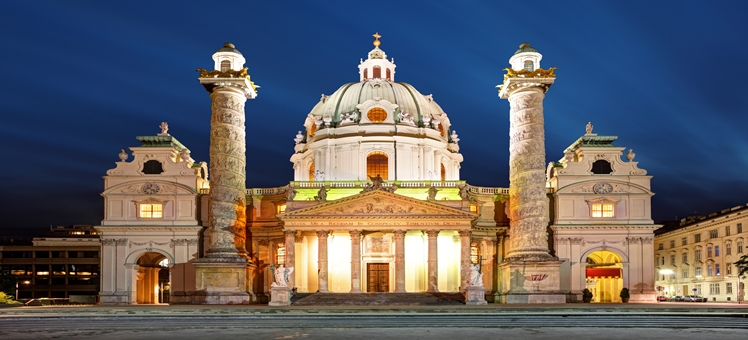
Full of palaces, huge former imperial buildings, rivers, mountains and lots and lots of museums, culture is at the heart of Vienna. Its recent history is fascinating and extremely well presented all over the city. A large part of Viennese modern culture is also relaxing in coffeehouses and watching the world go by, often outside important landmarks, bringing historical and modern day culture together.
KahlenbergStep out of the city and get the 38a bus up to Kahlenberg in the 19th district, a 484 meter high mountain for the best views over the city and even lower Austria. This is one of the most popular day trips from Vienna with locals and tourists. The mountain lies in the north eastern foothills of the eastern Alps, located in the 19th district of Vienna. On top of the mountain is a small church, St. Josef, and a 1930s restaurant. In the summer try local wine made from grapes from the nearby vineyards.
Schönbrunn Palace
This huge and extremely grand former imperial palace in the 15th district has 1,441 rooms. It was the summer residence of the former Emperor Franz Joseph. Today, it stands as one of the most important cultural monuments in the country and is now a well-loved tourist attraction. Inside, the rooms are decorated in the Rococo style – late Baroque about 18th century and draped in gold. The gardens are intricate and well kept, including a maze, tropical plants and the world’s oldest zoo. Enjoy the views of the palace and city from the Glorette.
Museumsquartier
Named after the huge amount of museums found here, including the Leopold Museum, you will find the area known as Museumsquartier, designed by Austrian architect Fischervon Erlach. With so many museums in one place, it is one of the most culturally ambitious spaces in the world. Inside the square are cafes, bars and restaurants to relax in between each cultural experience. Brightly colored large and boxy modern seating adorn the outside of eateries, bringing together the modern and historical architecture.
Freud’s Museum
If you’re a fan of Seigmund Freud and all things psychoanalysis, then head to Alsegrund, the 9th District for the Sigmund Freud Museum. The museum is the former home and office of Freud. Get a feel for his life and understand his work in the exhibition documenting his life at the Museum situated in Berggasse. Freud lived and worked in this simple house from 1891 to 1938 when he was forced to flee to England. The museum creators and Anna Freud, Sigmund’s youngest daughter, brought the house back to life with original furnishing and documents in 1971.
Donaukanal
The Donaukanal, a former arm of the River Danube, is a canal that runs through the centre of Vienna, namely the 2nd district. Either take a boat tour down the canal, or just hang out amongst the attractive and cool bars along the shore which is popular in summertime. There is even sand along the water’s edge to make you feel as though you are at the beach. Locals jog along the canal and it is ideal for people watching.
Hofburg Palace
Perhaps the most well-known symbol of Vienna in terms of culture and heritage is the Hofburg Palace in the 1st district, which has housed highly important families over the decades. Occupied by the Habsurg monarchy, the Swiss courtyard dates back to the 13th century but it has since had sections added on to it, accounting for its huge size. The palace has also housed Emperors, from the first in 1273, to the last in 1918.